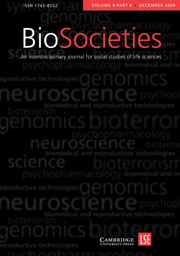Crossref Citations
This article has been cited by the following publications. This list is generated based on data provided by
Crossref.
Prainsack, Barbara
Reardon, Jenny
Hindmarsh, Richard
Gottweis, Herbert
Naue, Ursula
and
Lunshof, Jeantine E.
2008.
Misdirected precaution.
Nature,
Vol. 456,
Issue. 7218,
p.
34.
Rose, Nikolas
2008.
Race, Risk and Medicine in the Age of ‘Your Own Personal Genome’.
BioSocieties,
Vol. 3,
Issue. 4,
p.
423.
2008.
Anthropological Currents.
Current Anthropology,
Vol. 49,
Issue. 6,
p.
959.
Foster, Morris W.
2009.
Looking for race in all the wrong places: analyzing the lack of productivity in the ongoing debate about race and genetics.
Human Genetics,
Vol. 126,
Issue. 3,
p.
355.
Ellis, Rebecca
Waterton, Claire
and
Wynne, Brian
2010.
Taxonomy, biodiversity and their publics in twenty-first-century DNA barcoding.
Public Understanding of Science,
Vol. 19,
Issue. 4,
p.
497.
Shaw, Susan J.
2010.
The logic of identity and resemblance in culturally appropriate health care.
Health: An Interdisciplinary Journal for the Social Study of Health, Illness and Medicine,
Vol. 14,
Issue. 5,
p.
523.
Braun, Kathrin
and
Schultz, Susanne
2010.
“… a certain amount of engineering involved”: Constructing the public in participatory governance arrangements.
Public Understanding of Science,
Vol. 19,
Issue. 4,
p.
403.
Caduff, Carlo
2010.
Public prophylaxis: Pandemic influenza, pharmaceutical prevention and participatory governance.
BioSocieties,
Vol. 5,
Issue. 2,
p.
199.
Reardon, Jenny
2011.
The ‘Persons‘ and ‘Genomics‘ of Personal Genomics.
Personalized Medicine,
Vol. 8,
Issue. 1,
p.
95.
Barragán, Carlos Andrés
2011.
Racial Identities, Genetic Ancestry, and Health in South America.
p.
41.
Epstein, Steven
2011.
Misguided boundary work in studies of expertise: time to return to the evidence.
Critical Policy Studies,
Vol. 5,
Issue. 3,
p.
323.
Juengst, Eric T
Settersten, Richard A
Fishman, Jennifer R
and
McGowan, Michelle L
2012.
After the Revolution? Ethical and Social Challenges in ‘Personalized Genomic Medicine‘.
Personalized Medicine,
Vol. 9,
Issue. 4,
p.
429.
Hinterberger, Amy
2012.
Investing in Life, Investing in Difference: Nations, Populations and Genomes.
Theory, Culture & Society,
Vol. 29,
Issue. 3,
p.
72.
Hinterberger, Amy
2012.
Publics and Populations: The Politics of Ancestry and Exchange in Genome Science.
Science as Culture,
Vol. 21,
Issue. 4,
p.
528.
Reardon, Jenny
2012.
The Democratic, Anti-Racist Genome? Technoscience at the Limits of Liberalism.
Science as Culture,
Vol. 21,
Issue. 1,
p.
25.
McNeil, Maureen
2013.
Between a Rock and a Hard Place: The Deficit Model, the Diffusion Model and Publics in STS.
Science as Culture,
Vol. 22,
Issue. 4,
p.
589.
Pollock, Anne
2015.
On the Suspended Sentences of the Scott Sisters.
Science, Technology, & Human Values,
Vol. 40,
Issue. 2,
p.
250.
Merriman, Ben
and
Molina, Santiago J.
2015.
Variable conceptions of population in community resource genetic projects: a challenge for governance.
New Genetics and Society,
Vol. 34,
Issue. 3,
p.
294.
Burgess, Michael M.
Longstaff, Holly
and
O’Doherty, Kieran
2016.
Big Picture Bioethics: Developing Democratic Policy in Contested Domains.
Vol. 16,
Issue. ,
p.
263.
Nash, Catherine
2017.
The politics of genealogical incorporation: ethnic difference, genetic relatedness and national belonging.
Ethnic and Racial Studies,
Vol. 40,
Issue. 14,
p.
2539.

